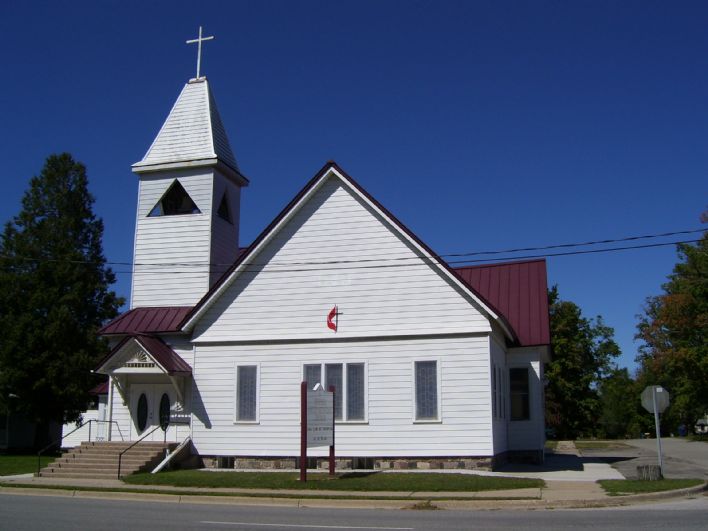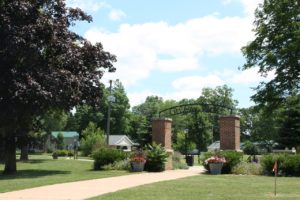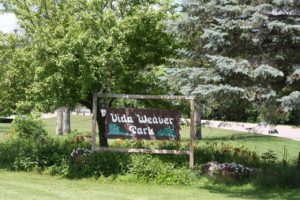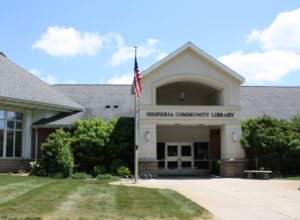The Founding of Hesperia
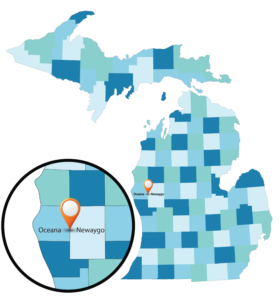 Lumbering was the reason people originally came to the area and like other settlements, Hesperia, a part of Michigan’s rich lumbering history, was primarily a logging town through the 1800’s. The White River, flowing through Hesperia, was used to move logs from forests to sawmills in the area.
Lumbering was the reason people originally came to the area and like other settlements, Hesperia, a part of Michigan’s rich lumbering history, was primarily a logging town through the 1800’s. The White River, flowing through Hesperia, was used to move logs from forests to sawmills in the area.
Daniel Weaver inspired the movement to establish a village on the banks of the White River where Oceana and Newaygo County met. Weaver had earlier settled and developed Fremont (originally known as Weaverville), and eventually moved his family to what is today, the Village of Hesperia. He was instrumental in creating a thriving logging town.
Weaver was attracted to the area by the power of the White River that was important for his interest in operating a sawmill closer to the White River so he would not need to haul the logs to the sawmill he owned in Fremont. When he visited the store owned by Joseph Sweet near the Michigan Avenue Bridge in 1865, he found level land and good waterpower. It was the building of a dam on the White River that spurred the growth of the village and led to its continued existence. The dam eventually provided electrical power to the village around 1911.
Weaver’s, son-in-law, Thaddeus Waters, began laying out the town in 1866 with assistance from William Hoskins, who had erected the first permanent home in the settlement in 1858. John P. Cook, joined the developing community and found the plat less than acceptable so he redrafted the layout with Waters to the present plat. They decided to call the village “New Ocea”. This was later changed to “Hesperia”. Cook, Weaver, and Rowland sections were added later.
Many of the settlements in Newaygo and Oceana Counties came and went as the forests were cleared of trees during the lumbering age in Michigan. What remained through all the years was the White River, the dam and a community of enterprising people. Logging and sawmills, which still operate yet today in the area, were replaced in a large part with agriculture and related commerce. The Hesperia Dam, which was it is believed to have been constructed around 1860, eventually brought to the Hesperia area another significant attraction, bountiful sport fishing.

The following timeline includes dates and events were found in the recorded minutes
of village council meetings and the Hesperia Centennial Book.
1858
William Hoskins, erected the first house at the corner of Smith Street & South Avenue just outside the present village.
1865
The “Log Store” was erected on the north side of the White River just outside the present village limits.
1866
Daniel Weaver and John Cook built a steam-operated sawmill near the present dam site.
1866
A school building was located on the flat north of the White River. The building was later moved to the northwest side of South Avenue and Division Street.
1866
Thaddeus Waters and John Cook platted the village.
1867
The first post office was established in Weaver’s Store.
1868
Hoskins, Weaver, and Cook deeded blocks “O” and “P” to the public for the Hesperia Public Park.
1871
Daniel Weaver built a flourmill on the north side of the White River.
1875
The first newspaper, The Hesperian, was founded by Daniel Weaver’s son, Daniel L. Weaver.
1877
Baptist Church was erected on South Division Street and Church Avenue.
1884
There was daily stagecoach service to Fremont and White Cloud.
1897
Frank Miller opened the first bank in Hesperia.
1901
The Mason and Oceana Rail Road Co. was granted permission to occupy Weaver Street for railroad purposes. The depot was not to exceed three hundred feet east of Greenback Street. (The railroad was never built.)
1910
The State Bank of Hesperia was organized.
1911
An ordinance was adopted abolishing saloons in the village.
The power house was built.
1914
Signs were erected to post speed limits for automobiles.
1916
The Woman’s Literary Club started the public library in the Rowland Building.
1922
Division Street was paved with cement from Weaver Street to Michigan Avenue.
1924
A traffic officer was hired when a petition from citizens wanted speed limits on automobiles to be enforced. (Citizens also suggested the village could secure service from the state police.)
1925
GAR received permission to erect a Soldier’s Monument.
1926
A well was put down in Weaver Park.
1933
The public library was moved to the Village Hall.
1934
The Greater Hesperia Business Association started a movement to consolidate Oceana and Newaygo Counties or to have the entire village in Newaygo County.
A beer license was issued as prohibition had recently ended.
A kitchen was added to Hesperia Public Park (Weaver Park).
1936
A jail cell was installed in the Fire Barn. The village hall had housed a jail cell since 1900.
1941
The first school bus was purchased by the school district.
1944
The volunteer Fire Depart was reorganized.
1947
First commercial garbage collection service was approved.
The Michigan Associated Telephone Company reported that dial conversion was in progress.
1948
A well was put in Webster Park.
Christ the King Catholic Church was established.
1949
The Hesperia Free Fair was organized.
Bus service included three runs daily from Hesperia to Muskegon. In one year, 48,000 passengers were transported.
1951
A 10 inch water well was installed to replace a 8 inch well that failed.
The village clerk was instructed to put up house numbers.
1952
Consumers Power gave the dam property to the village.
1953
The Carnation Milk Company was creating problems with their smoke stack and wastewater.
The Village Hall was razed and rebuilt in 1954.
The Chamber of Commerce and school board met at the village council meeting to discuss the need to take action to make the school better.
1954
There was a drive-in theater at the Rodeo Grounds.
1955
Two buildings were erected in Hesperia Public Park (Weaver Park) for the Hesperia Free Fair Association.
1956
Munn Street was created.
The Post Office was located in a brick building on Division Street just north of Michigan Avenue.
1962
William Branstrom built a 3,400 square foot library in Webster Park for the community in memory of his mother, Amelia.
1965
M-20 Highway from Hesperia to U.S.-31 was opened.
Michigan Consolidated Gas Co. brought natural gas service to Hesperia.
1966
The Baptist Church on Smith Street was built.
1967
An ordinance was adopted to not allow any more house trailers or mobile homes within the village limits.
1968
M-20 from Hesperia to White Cloud was rebuilt and widened.
1972
O.J. Morse Drive was platted.
1973
Don Turple announced plans for the Old Mill Camp
1975
Plans began for a wastewater collection and treatment facility.
Tennis and Shuffleboard Courts were added to Webster Park with a $14,500 grant from the state. The total cost of the project was $29,000.
1977
John and Mary Kuhart were paid $1,500 for 60 acres north of the White River for the sewer treatment project.
1978
The village bought what is now the present DPW building from Charles and Irene Morse for $25,000 to be used for managing the sewer treatment facility.
1980
The Wastewater collection and sewer treatment system began operating.
1981
A July 4th Celebration was started. Later became known as the Family Fun Fest.
1982
Cable Vision installed cable TV service in the village.
1983
The mobile home park was developed adjacent to the village. The village provides sewer service to park.
1986
A spillway was constructed at the dam site, after the stability of the dam was threatened during the flood.
1988
The Hesperia Beautification Committee was organized.
1989
The Michigan Department of Public Health required the village to construct and use an elevated water storage tank at a cost of $330,000.
1992
The DNR funded the Hesperia Scenic Area Project that included two ball fields, walkways to the islands above the dam, a boardwalk, parking area and bathrooms. The project was completed in 1994.
1993
911 emergency service commenced.
1997
A new pavilion and playground was added to Weaver Park.
1999
The Village Fire Department was dissolved. The village is served by the Hesperia Area Fire District that was formed by Newfield, Denver, and Greenwood Townships.
The village tried to get jurisdiction over the Hesperia Intercounty Drain district in order to have control of the repairs and improvements that were needed. The Drain Board voted to keep control and proceeded with the improvements that were assessed to properties in the district.
2001
A new post office was opened on Michigan Ave.
Division Street was improved from Sunset Drive to South Avenue with new curbing and water mains. The project included widening the street from two to three lanes.
2003
The North Division Street Bridge was reconstructed.


